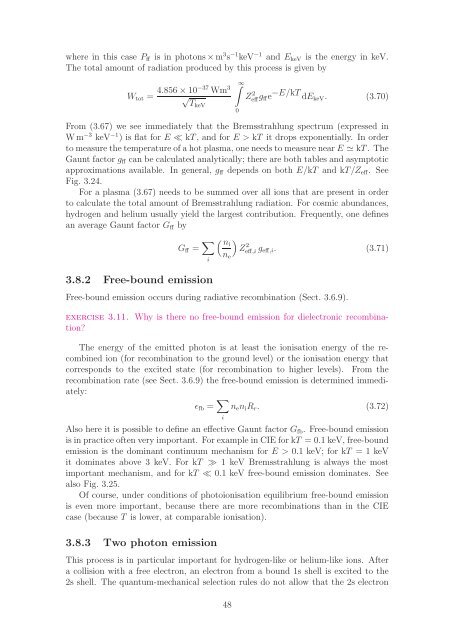Thermal X-ray radiation (PDF) - SRON
Thermal X-ray radiation (PDF) - SRON
Thermal X-ray radiation (PDF) - SRON
You also want an ePaper? Increase the reach of your titles
YUMPU automatically turns print PDFs into web optimized ePapers that Google loves.
where in this case P ff is in photons ×m 3 s −1 keV −1 and E keV is the energy in keV.<br />
The total amount of <strong>radiation</strong> produced by this process is given by<br />
W tot = 4.856 × 10−37 Wm 3<br />
√<br />
TkeV<br />
∫∞<br />
0<br />
Z 2 eff g ffe −E/kT dE keV . (3.70)<br />
From (3.67) we see immediately that the Bremsstrahlung spectrum (expressed in<br />
Wm −3 keV −1 ) is flat for E ≪ kT, and for E > kT it drops exponentially. In order<br />
to measure the temperature of a hot plasma, one needs to measure near E ≃ kT. The<br />
Gaunt factor g ff can be calculated analytically; there are both tables and asymptotic<br />
approximations available. In general, g ff depends on both E/kT and kT/Z eff . See<br />
Fig. 3.24.<br />
For a plasma (3.67) needs to be summed over all ions that are present in order<br />
to calculate the total amount of Bremsstrahlung <strong>radiation</strong>. For cosmic abundances,<br />
hydrogen and helium usually yield the largest contribution. Frequently, one defines<br />
an average Gaunt factor G ff by<br />
G ff = ∑ ( ni<br />
)<br />
Zeff,i 2 g eff,i . (3.71)<br />
n<br />
i e<br />
3.8.2 Free-bound emission<br />
Free-bound emission occurs during radiative recombination (Sect. 3.6.9).<br />
exercise 3.11. Why is there no free-bound emission for dielectronic recombination?<br />
The energy of the emitted photon is at least the ionisation energy of the recombined<br />
ion (for recombination to the ground level) or the ionisation energy that<br />
corresponds to the excited state (for recombination to higher levels). From the<br />
recombination rate (see Sect. 3.6.9) the free-bound emission is determined immediately:<br />
ǫ fb = ∑ i<br />
n e n i R r . (3.72)<br />
Also here it is possible to define an effective Gaunt factor G fb . Free-bound emission<br />
is in practice often very important. For example in CIE for kT = 0.1 keV, free-bound<br />
emission is the dominant continuum mechanism for E > 0.1 keV; for kT = 1 keV<br />
it dominates above 3 keV. For kT ≫ 1 keV Bremsstrahlung is always the most<br />
important mechanism, and for kT ≪ 0.1 keV free-bound emission dominates. See<br />
also Fig. 3.25.<br />
Of course, under conditions of photoionisation equilibrium free-bound emission<br />
is even more important, because there are more recombinations than in the CIE<br />
case (because T is lower, at comparable ionisation).<br />
3.8.3 Two photon emission<br />
This process is in particular important for hydrogen-like or helium-like ions. After<br />
a collision with a free electron, an electron from a bound 1s shell is excited to the<br />
2s shell. The quantum-mechanical selection rules do not allow that the 2s electron<br />
48
















